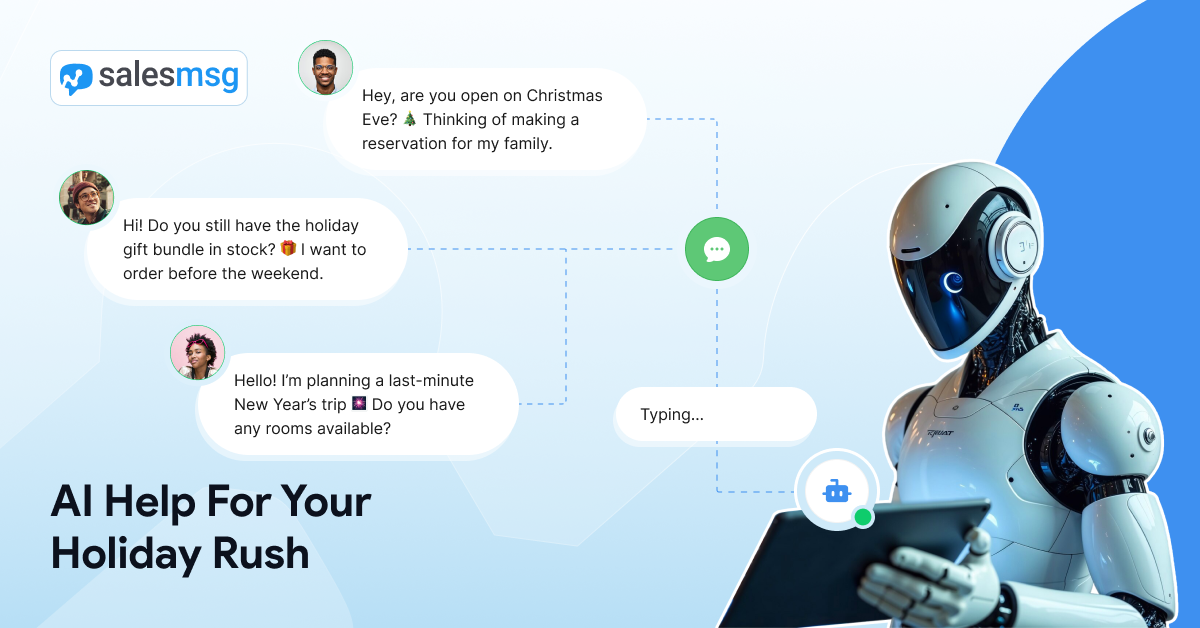SMS Deliverability Explained | Ensure Your Messages Reach

Does your business currently use texting to reach clients and customers?
If so, then this could all be coming to an end soon.
With upcoming carrier regulations being put into effect on September 1st, 2023. Making sure your business is ready is the difference between being able to text and not sending anything at all.
So, if you’ve been experiencing any SMS message blocking or filtering, then this is your wake-up call.
Below, we’ll clear up any confusion regarding SMS deliverability, so you know the exact steps to take to ensure you keep your high deliverability. You’ll also learn the SMS deliverability impacts on different phone numbers and the dos and don'ts of getting approved by your carrier.
Why SMS Deliverability is the Only Thing That Matters
Similar to email deliverability, SMS deliverability is when a message reaches the intended mobile device.
When you’re using SMS for your business, there’s only one thing that matters.
You know the old thought experiment: “If a tree falls in a forest and no one is around to hear it, will it make a sound?”
SMS deliverability is this tree falling. The deafening silence is what will happen to your messages if they aren’t delivered.
See, with business texting there are five main parts:
- Your message gets sent
- Your message gets delivered
- Your message gets read
- Your message gets opened
- Your message gets clicked or replied to
Notice, how for this chain to work, step two must be achieved. Without your message getting delivered, there’s no way you can use SMS to power your customer support, improve your marketing, or make your sales pipelines more efficient.
As a channel, it’s basically dead. That’s why SMS deliverability is a must-have component you need to get right.
Why These SMS Deliverability Changes Are Happening
You already know how great SMS is as a channel. It beats almost every other channel out there, email, direct mail, phone, and more. It gets the highest open and highest deliverability rates in the game.
However, since it’s been such a great channel for reaching current and new customers, this has opened it up for abuse. It’s been the wild west, so cell phone carriers are cracking down and creating new rules and regulations.
This isn’t done to punish businesses who are using texting, but instead to create a better experience all around. No one likes spam messages. Most Americans receive an average of 41 spam texts every month.
The goal of these new rules and regulations is to help maintain the integrity of the channel. Not only does this benefit carriers (texting makes them a ton of revenue), but it ensures users continue to value texting as a medium.
We’ve seen this happen before across another channel your business probably uses —email. With email, you have the main email service providers (ESPs), Google, Hotmail, Outlook, and AOL. To ensure their customers weren’t getting overwhelmed with spam they created new technologies.
Now, the big telecom companies are playing catch up.
There’s a lot of overlap between the big telecoms and ESPs, and how they handle spam and deliverability.
Here’s a more detailed look:

Both carriers and ESPs use a variety of technologies to block spam and blacklist senders. They also have verification tools to prove that business owners are who they say they are.
Understanding the Different Types of Phone Numbers and Deliverability Impacts

SMS deliverability will impact every type of business phone number, including short codes, local numbers, and toll-free numbers.
When it comes to registration and verification you’ve probably heard all kinds of acronyms getting thrown around: A2P, 10DLC, and Toll-Free Verification.
At the end of the day, the carriers want to know two things: who you are and what you’re sending.
With a short code, you’ll go through an application process known as Application to Person (A2P), with local you’ll do 10DLC, and for toll-free numbers, you’ll go through Toll-Free Verification.
On top of deliverability impacts, you’ll also see limits for the number of messages you can send daily, weekly, and monthly.
Plus, there are limits on the phone numbers you can use, based on the type of business you run.
Which leads us to the big question: Does your business have a USA Tax ID EIN?
If the answer is yes, then you can do local, toll-free, and shortcode texting.
If the answer is no, then you can’t do higher volume local numbers. However, both toll-free and short code messages are still available to you.

The type of phone number/s you use depends on the types of campaigns you’re running. For example, do you want to use it for two-way messaging, notifications, or broadcast messages? Also, what volume of messages do you want to send?
Understanding A2P 10DLC Registration
A2P registration is for local phone numbers and requires a USA EIN.
With this, you’ll be using a platform like Salesmsg (or another third-party provider) that provides text messaging or calling. If you’re using a personal cell phone, then you don’t need to do this.
But, if you’re using a third-party application, then this is now mandatory.
For A2P there are three things carriers require:
- Your business profile (AKA your company)
- Your brand (your trust score)
- Your use case (the campaigns you’ll be running)
To register there will be some carrier fees involved. These fees aren’t imposed by us, they’re direct from the carriers.
Here’s a quick look:

You’ll notice the fee for sole proprietors is much lower, this is because you’ll only be sending from a single number. Also, keep in mind that the monthly fees are per use case. So, you’ll be paying $10/mo for every use case you register.
Luckily, we’ve built these features directly into Salesmsg. So, all you need to do is literally fill in the blanks.

There are four different sections you’ll need to complete within Salesmsg. You start by adding your business location, EIN, business name, address, and more.
Overall, the more details you can provide, the better. For example, adding an IRS EIN document, and adding links to your business profiles on social media will help to speed up the process.
Understanding Toll-Free Verification
Toll-free verification is for toll-free numbers. There’s no EIN required for verification and use.
It follows a similar process to A2P 10DLC, but there’s no brand verification. All you need to do is submit your business profile and your use case.
As it stands today, there’s no carrier fee for toll-free verification. Note, this is subject to change in the future.
Best Practices for Getting Fast Approval and High SMS Deliverability
Getting approval and maintaining your high deliverability is all about meeting the new carrier requirements.
Right now, the key to getting approved and keeping your high deliverability is to nail your application.
Currently, it’s taking around 2 to 5 weeks to know if your application will be approved. However, you can streamline this by providing as much detailed and accurate information as possible about your business.
Here are the dos and don'ts of improving your approval chances. These aren’t just ideas either, these are battle-tested based after reviewing 1,000s of applications and seeing what gets accepted or rejected.
Submit Your Full Company Name, Address, and Authorized User Information
One of the first things you need to get right is your business name, address, and authorized user information. This needs to match what the carriers already have in their database. It also means you need to use your registered business name and registered business address. Make sure you get every detail right, including simple things like the first and last name of an authorized user.

Nail Your SMS Use Cases
Use cases might sound complex, but they’re simply the kinds of texts you’re going to be sending. The easiest way to get this right is to look at the types of messages you’ve already been sending to your users.
The important point here is to provide enough information, so the carriers can understand what you’re going to send. One-word sentences will get disapproved, you need to give enough context.
Here’s an example:

If you’re stuck with use cases, then let Salesmsg help you out. We have built-in use cases, like customer care messages, notifications, alerts, and sweepstakes. Simply select your use case from the drop-down list and add your description.
You also need to include message samples of each use case. You can pull these directly from your past SMS messages that were successful.

Opt-in Method and Images
Carriers also want to see how you got consent to send users messages. This can be from text to join keywords, web forms, someone texting in, and more. If you’re like most businesses, then you’ll select multiple methods for how users opt-in to receive messages.
Here’s what it’ll look like:

You’ll also need to provide opt-in descriptions too. First, you’ll write a description of each opt-in, similar to what you did previously.
Here are some examples of opt-in image descriptions that were approved and rejected:

You also need to provide images of each opt-in you’re using. These can be simple screenshots of your opt-ins in action:

How Salesmsg Can Help Streamline Verification and Ensure You Keep High SMS Deliverability
If everything above seems a little overwhelming, we get it. You’re down to the wire and want to ensure your business can keep texting your customers.
That’s why we’re here to help as much as possible.
As a Salesmsg user, we’ve streamlined the entire application process within our dashboard. Simply follow the steps and fill out every field with as much accurate detail as possible and there’s a good chance you’ll be approved.
However, we also offer a white glove compliance service. Here, we’ll handle the entire application process on your behalf. This ensures there are no mistakes that’ll lead to your application getting rejected. If you’re an annual plan member, then this is already included.
The beauty of having us in your corner is that we’ve seen it all. We’ve seen in real-time what mistakes will lead to your application being rejected and we can help you avoid these. So, you can be approved the first time and get back to texting your customers.
Here’s why you must act today:
In the eyes of the carriers, if you haven’t submitted your application, then you’re unregistered. And once the deadline hits, you’re cut off.
Now, approval doesn’t mean free reign. The carriers will still be monitoring messages. But, the only way to send messages is to get approval.
Without this golden stamp of approval, you can no longer use SMS as a marketing, sales, and support vehicle.
Salesmsg is the conduit to help you get approval, so you can keep your high SMS deliverability.



















